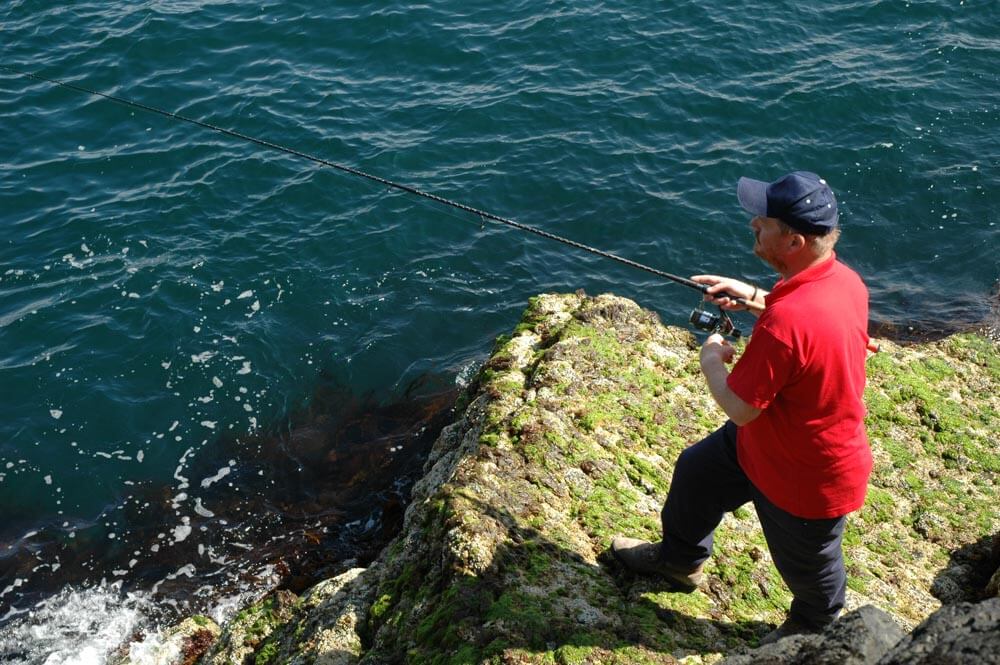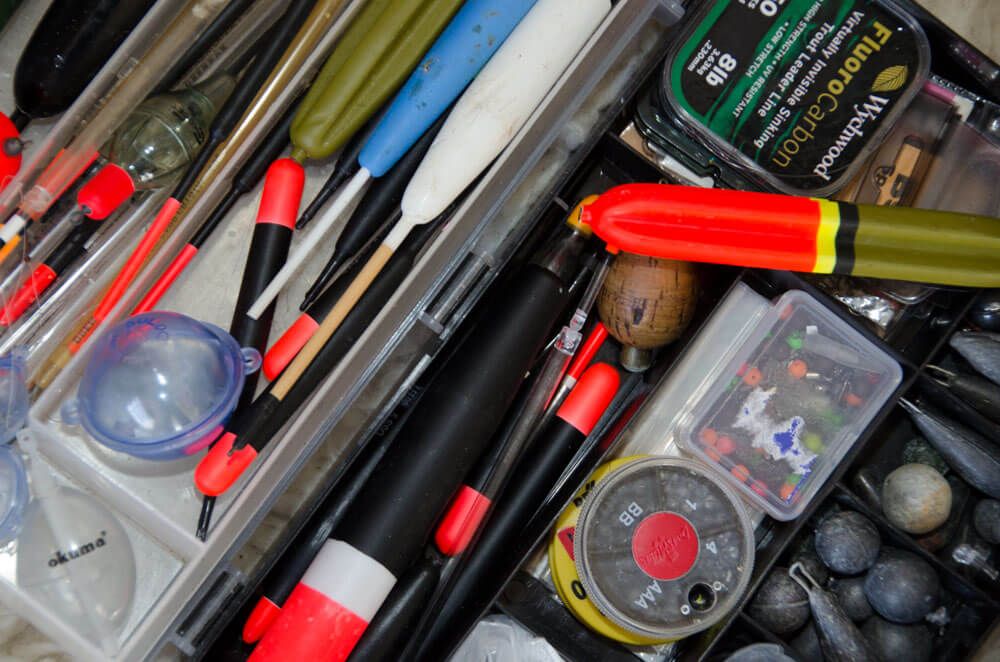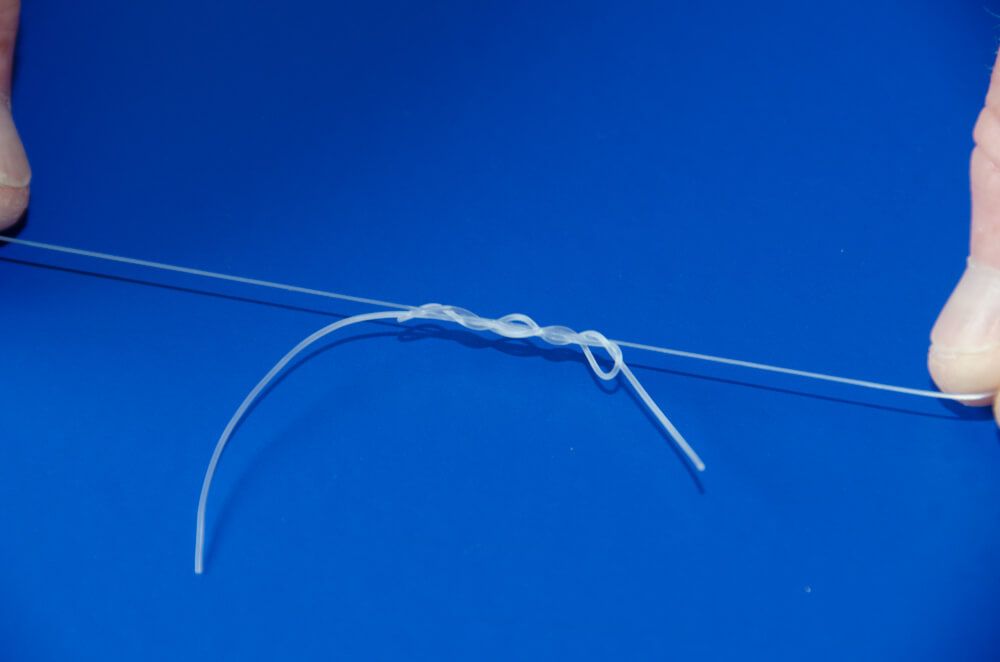Fishing with a float in the sea is a very effective, fascinating and at times very exciting method for catching a number of marine species. As you are using much lighter tackle than when bottom fishing, fish are able to show their full fighting ability. Float fishing is normally practiced in depths down to about 10 metres fairly close to the shore, so harbour walls and deep rock marks are ideal for this method. Although most float fishing is carried out in clear water it can be quite effective in cloudy conditions particularly if the bait is allowed to trail along the bottom.

TACKLE
For most situations a light carp rod is suitable but where the target fish are large wrasse and pollack a heavy carp/pike rod may be better to allow for a bit of bullying. The rod length should be 11/13ft as this length makes striking easier and also allows more control of both the float and hard fighting fish. Any reliable medium sized salt water resistant fixed spool reel will suffice. Load it with lines of 10-15lb B.S. for general fishing although lighter line of 6-8 lb B.S. may be suitable for shy mullet.
A selection of floats will be necessary to cover all the situations. The size and type of float employed will depend on wave size and depth. Generally the heavier the sea and the greater the depth the larger should be the float. When fishing in calm waters at depths of less than 3 metres it is quite possible to fish with the float fixed to the line. With greater depths a sliding float is the best option.

Weights are added to the line to sink the bait. These can be barrel leads, drilled bullets or split shot. Drilled bullets and barrel leads can be held in place with split shot or alternatively a swivel can be used as a stop. Fixed floats can be held in position with float rubbers top and bottom and the weights placed together. These are fine for fishing in light winds. Waggler type floats are more versatile as they can be fished in both calm and windy conditions with the line sunk. Wagglers are fixed bottom end only with most of the shot attached around the bottom ring and enough shot lower down to sink the bait. With sliding floats all weights are usually placed together. With all floats always add enough shot so that just the tip of the float remains above the surface.
It is necessary to use a stop knot when using sliding floats. I normally use a piece of elastic band hitched onto the line - power gum is an alternative. Whatever is used it should be small enough to pass through the rod rings fairly easily and not interfere with casting significantly when it is wound onto the spool of the reel. Some sliding floats have fairly large holes for the line to pass through and these can also allow the stop knot to pass through. This problem can be overcome by using a bead on the line between the float and the stop knot.

Hook size and pattern will depend on the bait. All types of bait are worth trying especially live ones such as prawns, shrimps and sandeels.
TECHNIQUE
When float fishing the depth at which the bait is held by the float is often critical to success. And don’t forget when fishing near the bottom, the float has to be constantly altered with the tide. Quite often bites will cease but when the float is reset to the correct depth, bites will start again proving the importance of fishing at the correct depth. When fishing near the bottom start by setting the float so the bait is held about 1 metre above the bottom. The depth is set by adding a weight to the hook which is large enough to sink the float. The stop knot is then moved until the float can be seen a metre below the surface. The depth can be adjusted until you start getting bites.
When fishing for mid water species such as mackerel, scad and garfish it is best to set the float at about 3 or 4 meters to start with. Garfish can be very shallow and are often in the first 2 metres.
Normally some or all of the weight will be fixed about 40- 80 cms from the hook so as the get the bait down quickly however fish sometimes respond to a bait that slowly sinks through the water. Many continental anglers fish with all the weight just below the float for species such as bream and mullet. I have myself caught mullet using this set up. When fishing “on the drop” in two metres or less then it makes sense to place all the weight directly below the float but it most situation it is only necessary to move the weight away from the hook towards the float. The bait will fall through a depth equivalent to twice the distance between the hook and the weight.
Many species can be caught when float fishing my list of float caught species, 23 in all, includes sea trout, cod, dogfish and grey gurnard amongst the more usual wrasse, pollack, coalfish, mackerel, scad, garfish, bass and mullet. My all time favourite though has to be a little John Dory I caught in Cornwall.
TIPS

TACKLE
For most situations a light carp rod is suitable but where the target fish are large wrasse and pollack a heavy carp/pike rod may be better to allow for a bit of bullying. The rod length should be 11/13ft as this length makes striking easier and also allows more control of both the float and hard fighting fish. Any reliable medium sized salt water resistant fixed spool reel will suffice. Load it with lines of 10-15lb B.S. for general fishing although lighter line of 6-8 lb B.S. may be suitable for shy mullet.
A selection of floats will be necessary to cover all the situations. The size and type of float employed will depend on wave size and depth. Generally the heavier the sea and the greater the depth the larger should be the float. When fishing in calm waters at depths of less than 3 metres it is quite possible to fish with the float fixed to the line. With greater depths a sliding float is the best option.

Weights are added to the line to sink the bait. These can be barrel leads, drilled bullets or split shot. Drilled bullets and barrel leads can be held in place with split shot or alternatively a swivel can be used as a stop. Fixed floats can be held in position with float rubbers top and bottom and the weights placed together. These are fine for fishing in light winds. Waggler type floats are more versatile as they can be fished in both calm and windy conditions with the line sunk. Wagglers are fixed bottom end only with most of the shot attached around the bottom ring and enough shot lower down to sink the bait. With sliding floats all weights are usually placed together. With all floats always add enough shot so that just the tip of the float remains above the surface.
It is necessary to use a stop knot when using sliding floats. I normally use a piece of elastic band hitched onto the line - power gum is an alternative. Whatever is used it should be small enough to pass through the rod rings fairly easily and not interfere with casting significantly when it is wound onto the spool of the reel. Some sliding floats have fairly large holes for the line to pass through and these can also allow the stop knot to pass through. This problem can be overcome by using a bead on the line between the float and the stop knot.

Hook size and pattern will depend on the bait. All types of bait are worth trying especially live ones such as prawns, shrimps and sandeels.
TECHNIQUE
When float fishing the depth at which the bait is held by the float is often critical to success. And don’t forget when fishing near the bottom, the float has to be constantly altered with the tide. Quite often bites will cease but when the float is reset to the correct depth, bites will start again proving the importance of fishing at the correct depth. When fishing near the bottom start by setting the float so the bait is held about 1 metre above the bottom. The depth is set by adding a weight to the hook which is large enough to sink the float. The stop knot is then moved until the float can be seen a metre below the surface. The depth can be adjusted until you start getting bites.
When fishing for mid water species such as mackerel, scad and garfish it is best to set the float at about 3 or 4 meters to start with. Garfish can be very shallow and are often in the first 2 metres.
Normally some or all of the weight will be fixed about 40- 80 cms from the hook so as the get the bait down quickly however fish sometimes respond to a bait that slowly sinks through the water. Many continental anglers fish with all the weight just below the float for species such as bream and mullet. I have myself caught mullet using this set up. When fishing “on the drop” in two metres or less then it makes sense to place all the weight directly below the float but it most situation it is only necessary to move the weight away from the hook towards the float. The bait will fall through a depth equivalent to twice the distance between the hook and the weight.
Many species can be caught when float fishing my list of float caught species, 23 in all, includes sea trout, cod, dogfish and grey gurnard amongst the more usual wrasse, pollack, coalfish, mackerel, scad, garfish, bass and mullet. My all time favourite though has to be a little John Dory I caught in Cornwall.
TIPS
- Use a float which will just remain above the waves or just support enough shot to carry the bait down when fishing in calm water.
- Ground bait can be very effective when float fishing but make sure you are baiting the area you are fishing otherwise you will be attracting the fish away from you.
- Sometimes fish like pollack and wrasse will not be spread evenly around the area you are fishing but will be found in one particular spot.
- Quite often fish spot the bait and come over to investigate so re-casting often produces a bite.
- In a similar way fishing a slow sinking bait can prove irresistible to some fish.
- When fishing very rough ground use a weaker hook length which will break before the main line saving your float and weights. Join the hook length and main line to a swivel and place your weights above.
- If you find your hook length lays across the float and tangles the main line when you cast, add a split shot above the weights so that when the bait swings towards the float the float is held away from it so it can’t reach it.

